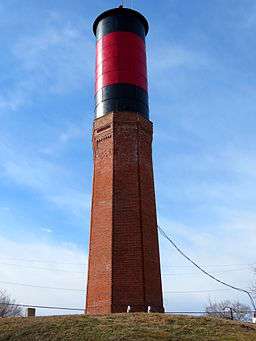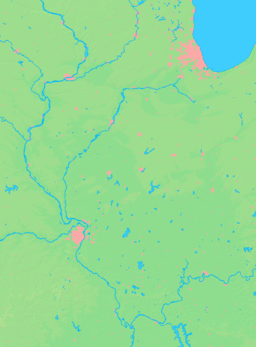Havana, Illinois
| Havana | |
| City | |
 Havana Water Tower | |
| Country | United States |
|---|---|
| State | Illinois |
| County | Mason |
| Elevation | 477 ft (145 m) |
| Coordinates | 40°17′49″N 90°3′36″W / 40.29694°N 90.06000°WCoordinates: 40°17′49″N 90°3′36″W / 40.29694°N 90.06000°W |
| Area | 2.91 sq mi (8 km2) |
| - land | 2.74 sq mi (7 km2) |
| - water | 0.16 sq mi (0 km2) |
| Population | 3,577 (2000) |
| Density | 1,361.0/sq mi (525/km2) |
| Timezone | CST (UTC-6) |
| - summer (DST) | CDT (UTC-5) |
| Postal code | 62644 |
| Area code | 309 |
  Location of Havana within Illinois | |
| Wikimedia Commons: Havana, Illinois | |
Havana is a city in Mason County, Illinois, United States. The population was 3,577 at the 2000 census, and 3,260 at a 2009 estimate. It is the county seat of Mason County.[1]
History
The city was named after Havana, the capital of Cuba.[2]
Geography
Havana is located on the Illinois River at 40°17′49″N 90°3′36″W / 40.29694°N 90.06000°W (40.297067, -90.060004).[3] It is located near the Chautauqua National Wildlife Refuge, and a short distance from Bath, Illinois. Havana was notorious as a gambling river town, and it is reported that names such as Al Capone would hunt, fish, and gamble in the local clubs. According to the 2010 census, Havana has a total area of 2.905 square miles (7.52 km2), of which 2.74 square miles (7.10 km2) (or 94.32%) is land and 0.165 square miles (0.43 km2) (or 5.68%) is water.[4]
According to the United States Census Bureau, the city has a total area of 2.8 square miles (7.2 km²), of which, 2.6 square miles (6.8 km²) of it is land and 0.2 square miles (0.4 km²) of it (5.40%) is water.
Demographics
| Historical population | |||
|---|---|---|---|
| Census | Pop. | %± | |
| 1850 | 462 | — | |
| 1870 | 1,785 | — | |
| 1880 | 2,118 | 18.7% | |
| 1890 | 2,525 | 19.2% | |
| 1900 | 3,268 | 29.4% | |
| 1910 | 3,525 | 7.9% | |
| 1920 | 3,614 | 2.5% | |
| 1930 | 3,451 | −4.5% | |
| 1940 | 3,999 | 15.9% | |
| 1950 | 4,379 | 9.5% | |
| 1960 | 4,363 | −0.4% | |
| 1970 | 4,376 | 0.3% | |
| 1980 | 4,277 | −2.3% | |
| 1990 | 3,610 | −15.6% | |
| 2000 | 3,577 | −0.9% | |
| 2010 | 3,301 | −7.7% | |
| Est. 2015 | 3,076 | [5] | −6.8% |
As of the census[7] of 2000, there were 3,577 people, 1,467 households, and 981 families residing in the city. The population density was 1,361.0 people per square mile (525.1/km²). There were 1,587 housing units at an average density of 603.8/sq mi (233.0/km²). The racial makeup of the city was 98.49% White, 0.14% African American, 0.14% Native American, 0.53% Asian, 0.06% from other races, and 0.64% from two or more races. Hispanic or Latino of any race were 0.59% of the population.
There were 1,467 households out of which 28.9% had children under the age of 18 living with them, 49.8% were married couples living together, 12.5% had a female householder with no husband present, and 33.1% were non-families. 29.6% of all households were made up of individuals and 17.2% had someone living alone who was 65 years of age or older. The average household size was 2.35 and the average family size was 2.88.
In the city the population was spread out with 23.7% under the age of 18, 8.3% from 18 to 24, 25.7% from 25 to 44, 20.1% from 45 to 64, and 22.3% who were 65 years of age or older. The median age was 40 years. For every 100 females there were 87.5 males. For every 100 females age 18 and over, there were 83.7 males.
The median income for a household in the city was $30,316, and the median income for a family was $35,684. Males had a median income of $30,833 versus $21,215 for females. The per capita income for the city was $16,781. About 10.2% of families and 12.0% of the population were below the poverty line, including 18.9% of those under age 18 and 7.5% of those age 65 or over.
Notable people
- Fred Beck, MLB player for the Boston Doves, Cincinnati Reds and Philadelphia Phillies
- Roy Hamey, MLB executive (New York Yankees)
- Scott W. Lucas, United States Senator from Illinois
- Paul Samuell, Illinois Supreme Court justice
References
- ↑ "Find a County". National Association of Counties. Retrieved 2011-06-07.
- ↑ Gannett, Henry (1905). The Origin of Certain Place Names in the United States. Govt. Print. Off. p. 152.
- ↑ "US Gazetteer files: 2010, 2000, and 1990". United States Census Bureau. 2011-02-12. Retrieved 2011-04-23.
- ↑ "G001 - Geographic Identifiers - 2010 Census Summary File 1". United States Census Bureau. Retrieved 2015-12-27.
- ↑ "Annual Estimates of the Resident Population for Incorporated Places: April 1, 2010 to July 1, 2015". Retrieved July 2, 2016.
- ↑ "Census of Population and Housing". Census.gov. Retrieved June 4, 2015.
- ↑ "American FactFinder". United States Census Bureau. Retrieved 2008-01-31.
External links
- City of Havana Online
- The Nature Conservancy's Emiquon Project - The Emiquon Project, a 7,000 acres (28 km2) wetland restoration project, is located across the Illinois River from Havana
- Historic Water Tower
- Havana City Data
- Havana Attractions